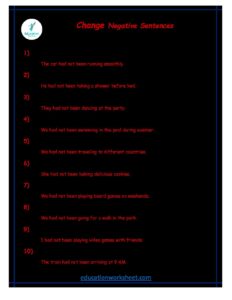Change Simple Present tense to Present Perfect Continuous tense negative 20 worksheets
Description of Change Simple Present tense to Present Perfect Continuous tense negative
Change Simple Present tense to Present Perfect Continuous tense negative to Present Perfect Continuous Tense in the negative form represents a significant shift in English grammar, allowing us to express ongoing actions that began in the past and continued up to the present moment, but are now negated. This transformation adds depth and nuance to our language by emphasizing both the duration of the action and its negative status. In this comprehensive guide, we will explore the step-by-step process of converting a sentence into the negative Change Simple Present tense to Present Perfect Continuous tense negative , providing you with a thorough understanding of this grammatical transformation.
Change simple present tense to past perfect continuous form negative

Understanding Change Simple Present tense to Present Perfect Continuous tense negative : Simple Present Tense is a verb tense used to describe actions, events, or states of being that are happening now, regularly, or as a general truth. In its negative form, “do not” or “does not” is typically used before the base form of the verb.
Understanding Change Simple Present tense to Present Perfect Continuous tense negative : Present Perfect Continuous Tense is used to express actions that started in the past, have continued up to the present, and may continue into the future. This tense is formed using the auxiliary verb “have” or “has,” followed by “been,” and then the present participle form of the main verb (-ing form).
Step-by-Step Transformation:
- Identify the Change Simple Present tense to Present Perfect Continuous tense negative : Start by identifying the sentence in Simple Present Tense that you want to convert to the negative Present Perfect Continuous form. Let’s use an example sentence:Simple Present Tense: “She does not play the piano regularly.”
- Identify the Main Verb: In our example sentence, the main verb is “play.” It’s crucial to identify the main verb because it will undergo changes in the transformation.
- Determine the Appropriate Auxiliary Verb for Present Perfect Continuous: In the negative Present Perfect Continuous form, we use “have not” or “has not” (depending on the subject) as the auxiliary verb. For “she,” we use “has not.”
- Convert the Main Verb to Its Present Participle Form: Transform the main verb “play” into its present participle form by adding “-ing.” The present participle form of “play” is “playing.”
- Use the Correct Auxiliary Verb and Add “Not”: Insert the auxiliary verb “has not” before “been” and then add “playing” to create the negative form.Negative Present Perfect Continuous: “She has not been playing the piano regularly.”
Change simple present tense to past perfect continuous form negative

- Understand the Resulting Sentence: The transformed sentence now communicates that she has not been engaging in the activity of playing the piano regularly, emphasizing both the duration of her non-engagement and its negative status.
Why Use Change Simple Present tense to Present Perfect Continuous tense negative :
The negative Present Perfect Continuous form is valuable for expressing ongoing actions or activities that have not been happening as expected or desired. It allows us to convey the duration of the negative status, indicating a change or lack of continuity in behavior.
Example Change simple present to present perfect continuous tense negative
Examples of Negative Present Perfect Continuous Sentences:

- “I have not been exercising lately.”
- This sentence suggests that the speaker has not been engaging in exercise, highlighting the duration of their inactivity.
- “They have not been studying for the exam.”
- Here, the negative form of Present Perfect Continuous implies that the lack of studying has persisted, emphasizing its impact on their exam preparedness.
- “He has not been practicing the guitar as he should.”
- This statement conveys that the individual’s failure to practice the guitar has continued over time, with potential consequences for their skill development.


